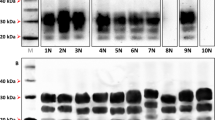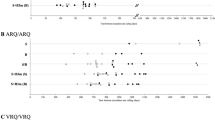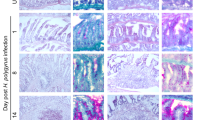Abstract
IN mice injected with mouse-passaged scrapie, the earliest rise in titre of agent is found in organs of the lymphoreticular system—irrespective of whether the injection is intracerebral or by a peripheral route1–4. The titre of agent in the spleen, for example, can rise fairly quickly to a moderate plateau level and subsequently starts to increase progressively in the brain, where it reaches, during the clinical phase, a greater concentration than elsewhere. These generalisations are based on work in various laboratories with agent strain–mouse strain combinations having relatively short incubation periods in the range 150–300 d after injection of high doses of agent. Evidence of replication in the spleen is therefore an indication that the animal will eventually develop scrapie if it lives long enough.
This is a preview of subscription content, access via your institution
Access options
Subscribe to this journal
Receive 51 print issues and online access
$199.00 per year
only $3.90 per issue
Buy this article
- Purchase on Springer Link
- Instant access to full article PDF
Prices may be subject to local taxes which are calculated during checkout
Similar content being viewed by others
References
Eklund, C. M., Kennedy, R. C., and Hadlow, W. J., J. infect. Dis., 117, 15 (1967).
Dickinson, A. G., and Fraser, H., J. comp. Path., 79, 363 (1969).
Clarke, M. C., and Haig, D. A., Res. vet. Sci., 12, 195 (1971).
Hunter, G. D., Kimberlin, R. H., and Millson, G. C., Nature new Biol., 235, 31 (1972).
Dickinson, A. G., Genetics, 79, 387 (1975).
Outram, G. W., Dickinson, A. G., and Fraser, H., Nature, 241, 536 (1973).
Dickinson, A. G., and Meikle, V. M. H., Molec. gen. Genet., 121, 73 (1971).
Fraser, H., Proc. sixth Int. Congr. Neuropath., 897 (Masson, Paris, 1970).
Dickinson, A. G., Fraser, H., Meikle, V. M. H., and Outram, G. W., Nature new Biol., 237, 244 (1972).
Outram, G. W., in Slow Virus Diseases, ch. 14 (edit. by Kimberlin, R. H.) (Elsevier, Amsterdam, in the press).
Duffy, P., Wolf, J., Collins, G., De Voe, A. G., Streeten, B., and Cowen, D., New Engl. J. Med., 290, 692 (1974).
Author information
Authors and Affiliations
Rights and permissions
About this article
Cite this article
DICKINSON, A., FRASER, H. & OUTRAM, G. Scrapie incubation time can exceed natural lifespan. Nature 256, 732–733 (1975). https://doi.org/10.1038/256732a0
Received:
Accepted:
Issue Date:
DOI: https://doi.org/10.1038/256732a0
This article is cited by
-
Prion strains: shining new light on old concepts
Cell and Tissue Research (2023)
-
Transmission of scrapie prions to primate after an extended silent incubation period
Scientific Reports (2015)
-
The prion hypothesis: from biological anomaly to basic regulatory mechanism
Nature Reviews Molecular Cell Biology (2010)
-
Recombinant prion protein induces a new transmissible prion disease in wild-type animals
Acta Neuropathologica (2010)
Comments
By submitting a comment you agree to abide by our Terms and Community Guidelines. If you find something abusive or that does not comply with our terms or guidelines please flag it as inappropriate.



